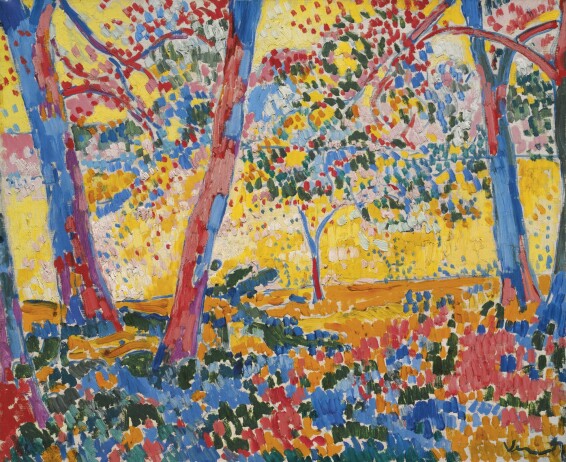- 14
毛利斯·德·弗拉芒克
描述
- Maurice de Vlaminck
- 《樹蔭下(風景)》
- 款識:畫家簽名 Vlaminck(右下)
- 油彩畫布
- 23 5/8 x 28 1/2 英寸
- 60 x 72.5 公分
來源
Jean Metthey, Paris (acquired in June 1953)
Jacques Lindon, New York & Paris
Knoedler & Co., New York (acquired from the above in April 1954)
Sarah Campbell Blaffer, Houston (acquired from the above on March 16, 1954)
Cecil Blaffer Hudson von Fürstenberg, Houston & New York (acquired by descent from the above circa 1960)
Acquired by descent from the above in 2007
展覽
Dallas Museum of Art, Les Fauves, 1959, no. 43
The Museum of Fine Arts Houston, From Gauguin to Gorky in Cullinan Hall, 1960, no. 19, illustrated in the catalogue (dated circa 1904)
New York, Paul Rosenberg & Co., Seven Decades 1895-1965: Crosscurrents in Modern Art, 1966, no. 85, illustrated in the catalogue
New York, Perls Galleries, Vlaminck (1876-1958) His Fauve Period: (1903-1907), 1968, no. 14, illustrated in the catalogue (titled Paysage Fauve)
Paris, Galerie de La Presidence, Maurice Vlaminck, 1987, no. 1, illustrated in color in the catalogue (titled Paysage and dated 1904)
Chartres, Musee des Beaux-Arts & Aosta, Centro Saint-Benin, Vlaminck, le peintre et la critique, 1987-88, no. 7, illustrated in color in the catalogue (dated 1904)
Tokyo, Mitsukoshi; Osaka, Mitsukoshi; Takamatsu, Mitsukoshi; Sapporo, Mitsukoshi; Kokura, Izutsuya & Okayama, Temmaya, Exposition Vlaminck, pionnier du fauvisme, 1989, no. 2, illustrated in color in the catalogue (dated 1904)
Los Angeles County Museum of Art; New York, Metropolitan Museum of Art & London, Royal Academy of Arts, The Fauve Landscape: Matisse, Derain, Braque and their Circle, 1904-1908, 1990-91, no. 339, illustrated in color in the catalogue (dated 1904)
Barcelona, Centre Cultural Caixa Catalunya, Els anys fauves / Les Années Fauves, 1904-1908, 2000-01, no. 57, illustrated in color in the catalogue (dated 1904-05)
Musée de Lodève, Derain et Vlaminck, 1900-1915, 2001, no.16, illustrated in color in the catalogue
São Paulo, Musée d'Art Brésilien, Fondation Armando Alvares Penteado, Vlaminck 1876-1958, 2001, no. 3, illustrated in color in the catalogue
出版
Ellen C. Oppler, Fauvism Reexamined, New York & London, 1976, illustrated p. 113
Massimo Carrà, Vlaminck, Milan, 1990, no. 6, illustrated in color (dated 1904)
Maïthé Vallès-Bled, Maurice de Vlaminck, oeuvres 1900-1956, Paris, 1991, no. 9, illustrated in color (dated 1904)
Vlaminck, Un instinct fauve (exhibition catalogue), Musée du Luxembourg, 2008, Paris, n.n., illustrated in color p. 24
Maïthé Vallès-Bled, Vlaminck: Critical Catalogue of Fauve Paintings and Ceramics, The Fauve Period 1900-1907, Paris, 2008, no. 63, illustrated in color p. 170
拍品資料及來源
Of all of the Fauve painters, Vlaminck was perhaps one of the most vocal about the trans-sensory impact of vibrant color. He would frequently use musical and visual qualifiers interchangeably in his descriptions of his art, enabling him to express the powerful, multi-sensual experience he attempted to convey in his paintings. ''When I had spent a few days without thinking, without doing anything, I would feel a sudden urge to paint" Vlaminck once recalled of this period. "Then I would set up my easel in full sunshine [...] Vermilion alone could render the brilliant red of the tiles on the opposite slope. The orange of the soil, the harsh crude colours of the walls and greenery, the ultramarine and cobalt of the sky achieved an extreme harmony that was sensually and musically ordered. Only the series of colours on the canvas with all their power and vibrancy could, in combination with each other, render the chromatic feeling of that landscape" (quoted in Gaston Diehl, The Fauves, New York, 1975, p. 104).
This fascination with brilliant, vibrant colors is magnificently reflected in Sous-bois, which probably depicts a scene near Chatou, where Vlaminck lived at the time. The artist rarely left this region during his Fauve years, preferring its surroundings along the Seine over the landscapes of the south of France, favored by Matisse, Derain and Braque. Vlaminck moved to the island of Chatou in 1892, at the age of sixteen, and became deeply attached to this area. He drew inspiration for most of his early landscapes from this region, many of them characterized by the red-tiled roofs typical of the surrounding villages. It was in Chatou, the birth place of André Derain, that the two artists met by chance in 1900, and subsequently formed a partnership that became the core of the Fauve movement. Vlaminck and Derain shared a studio, and over the following years regularly painted together, often depicting the same views of the local landscape.
The present work was acquired in 1954 by Sarah (Sadie) Campbell Blaffer, an art patron and philanthropist, and has remained with the family for over sixty years. Blaffer was the daughter of William Thomas Campbell, the founder of the Texas Company (later known as Texaco), and Sarah Campbell (née Turnbull). Sarah’s lifelong love for supporting the arts began during a visit to the Louvre during her honeymoon with her husband Robert E. Lee Blaffer (the founder of the Humble Oil & Refining Co., now Exxon Mobil). Together, the Blaffers amassed a comprehensive collection of works ranging from Old Master paintings to Impressionist and Modern masterworks. Mrs. Blaffer was an early benefactor of the Museum of Fine Arts, Houston, where she later donated a large portion of her collection. Following her death, the present work was inherited by her daughter Cecil Blaffer Hudson von Fürstenberg (also known as Titi von Fürstenberg).

